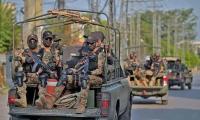Even if some divine interventions enable the Sindh and federal governments to run the Karachi Circular Railway (KCR), its operational model designed by the Sindh government does not seem financially viable.
The News has found that the project would incur an average yearly loss of Rs7.08 billion which is 25 times more than the current year’s development budget of the Sindh environment sector.
To cover this financial loss, the Sindh government will have to provide an annual subsidy of the same amount, which is 27.58 per cent of the funds allocated for the education sector in the current Annual Development Programme (ADP) 2019-2020.
Moreover, this amount of subsidy is also more than the total allocation for the mega projects of Karachi in the ADP as the funds for various mega projects in the city are 91.8 per cent of this required subsidy.
After an official of the Sindh Mass Transit Authority (SMTA) pointed out how much flawed the operational model of the KCR was, The News obtained its feasibility study and modified PC-1 prepared by the authority in July 2017.
Both the documents assume that the construction work of the KCR would start in September 2017 and its operations would start in December 2020. It must also be taken into account that the economic indicators of the country in 2017 were much better than what they are today and when the figures estimated in 2017 show the need of a heavy annual subsidy of Rs7.08 billion for the project, the actual required subsidy will likely be higher if the project somehow starts operations.
Sindh Transport Secretary Ghulam Abbas Detho said the feasibility study and the PC-1 of the project were prepared in 2017 in the light of the Japan International Corporation Agency’s (Jica) study particularly carried out for the KCR, which has now become redundant.
Moreover, the PC-1 also does not take into account the development of various bus rapid transit projects in the city that will likely affect the revenue of the KCR. Due to these reasons, the project may turn out as a white elephant for the government, the heavy financial requirements for which would be fulfilled at the expense of other development projects, said the SMTA official.
Possibility of operations?
The Supreme Court of Pakistan has ordered the federal government-run Pakistan Railways and the Sindh government to make the KCR functional in three months and demolish all the buildings on the circular railway’s route. The task seems to be nearly impossible for both the governments.
The reason why the circular railway cannot be made functional in three months is that the new master plan of the KCR prepared by the Sindh government shows that it is going to be 70 per cent elevated. The project will run 12.63 kilometres (km) at grade and 30.75km on an elevated track. The total number of the railway stations, as per the plan, will be 24, of which 14 will be constructed on an elevation. The average distance between two stations will be 1.8km.
Currently, no work has started for the construction of the elevated track and given the past record of both the federal and Sindh governments, it is a safe assumption that nothing substantial is going to happen on the project in three months.
However, even if the Sindh government by some miracle removes all the encroachments and ensures all the required constructions, starting the KCR would land it in severe financial troubles due to the following reasons.
Financial viability?
Analysing the modified PC-1 of the project shows how much the project is not financially feasible and how much the authorities urgently need to revisit its operational design before they end up constructing it in a haphazard manner.
The story of the restoration of the KCR starts from the year 2009 when the Japan International Cooperation Agency (Jica) had showed interest in the project and conducted studies such as the Karachi Transport Improvement Project (KTIP) to help the Sindh government make this project functional. However, due to a deadlock between the two over the agency’s financial commitment for the project, Jica got out and the China-Pakistan Economic Corridor (CPEC) came in. At present, it has been announced that the project has been included in the CPEC.
The estimated cost of the KCR project under Jica was Rs246.58 billion with 0.1 per cent interest rate that was supposed to be returned in 40 years. On the contrary, the new feasibility study by SMTA in July 2017 suggests that the total investment cost of the project will be $2.078 billion.
Keeping a conservative approach, if we assume that the yearly rise in the cost since 2017 has been three per cent, the cost of the KCR presently becomes $2.3 billion, which is equivalent to Rs355 billion after applying the exchange rate as on February 16, 2020, when this story
was filed.
Cost-benefit analysis
The modified PC-1 of the project clearly reveals that the project is not financially feasible as its financial benefit to cost ratio, which needs to be higher than 1 in order for any project to be profitable, is 0.78. However, it is a norm in such construction projects that this ratio is less than 1, due to which they require government subsidies.
Almost all such infrastructure projects are not financially viable and require government subsidy, but the question remains about their sustainability in the longer run.
The financial rate of return (FIRR) of the KCR is 5.34 per cent. The FIRR is a measure of how much the project’s financial returns are vulnerable to inflation and interest rate in the country. “The FIRR should have been at least 10 to 12 per cent for the KCR,” the SMTA official said on condition of anonymity.
According to the official, the FIRR of Lahore’s Orange Line Metro Train is 11.59 per cent, which is still considered bad. The net present value (NPV), which means how much benefit the project will generate in terms of money once the cost has been incurred, is negative $1 billion for the KCR.
The annexure 4.4 of the modified PC-1, which is the derivation of the FIRR, calculates the financial returns and ratios of the project in case its cost gets increased by 10 per cent, or its benefit gets decreased or in the worst case, both of the aforementioned changes happen.
However, according to PhD scholar Muhammad Amin, the provision of only 10 per cent increase in the cost is an extreme underestimation in the present economic scenario.
According to the worst case scenario in the PC-1, which should not be the worst case considering the ground economic realities today, the project will have a negative $1.376 billion NPV over 30 years. Based on this value, the yearly loss of the project is estimated at $45.86 million or Rs7.08 billion.
This yearly loss has to be covered through subsidy. The SMTA official feared that the revenue collection of the KCR would also decrease over a period of time because the operational model of the project is redundant and flawed as it is based on an outdated KTIP study conducted by Jica.
The KTIP did also not contain any calculations for a scenario like today when some BRT prjects have been constructed and are likely to get started before the KCR. Initially, the Japanese agency wanted to undertake the KCR and all the BRT projects of Karachi that would feed the circular railway. However, when Jica walked out, the federal government undertook the Green Line BRT, the track of which is complete from Surjani Town to Gurumandir. Later, the World Bank and the Asian Development Bank (ADB) were involved in the Yellow Line and Red Line BRTs respectively.
The construction of the Red Line BRT is likely to kick off from August this year, for which the Sindh government has inked an agreement with the ADB. The line will run from Model Colony to the Mazar-e-Quaid.
As for the Yellow Line BRT, an agreement with the World Bank has been inked. The project will join Dawood Chowrangi in Landhi with Numaish.
As per the ADB’s concept, the Red Line project has been designed in such a way that it will be self-sustaining with no operational deficits. “Same is the World Bank’s vision for the Yellow Line,” the SMTA official said and added that after two years of different studies for the Red Line BRT, the transport department believed that the project will have a subsidy-free operating system once it starts running in full swing.
“The Red Line is designed for 25,000 people per hour per direction,” the official shared, adding that by the time the KCR would be operational, the Red Line BRT and the Green Line BRT would already have been functional.
“If the KCR would have been operating without the BRT, it would have gotten all the ridership,” the official remarked and explained how the circular railway needed one million passengers per day to be sustainable.
Disputed KUTC
One of the major reasons for the delay in the project, which resulted in a drastic increase in the project’s cost and also made it dependent on heavy subsidy, is the delay in the transfer of the Karachi Urban Transport Corporation (KUTC) from the federal government to the provincial government.
The KUTC is a regulatory authority for the implementation of the KCR project registered with the Security and Exchange Commission of Pakistan (SECP) as a public limited company in 2008. Under the current KUTC model, the Pakistan Railways has its share of 60 per cent in the KCR revenue while the Sindh government and the local government have 25 and 15 per cent shares respectively.
Once the corporation is transferred to the Sindh government, the land of the circular railway will also be handed over to the provincial government.
Had the project been transferred to the Sindh government earlier, the Sindh transport secretary says, the KCR would have been operating right now at a much cheaper cost. Talking to The News, he said that from the year 2008 till 2012, studies were conducted to find a way to make the project financially viable, but it was proven that the KCR could not be run without subsidy.
The estimated ridership of the KCR is 550,000 per day, Detho said. He, however, agreed that it would be very painful for the government to pay heavy subsidy for the project.
This photograph shows commuters driving on a busy street in Karachi. — AFP/FileFrom the River to the SeaThe Sanat...
The Sindh High Court Hyderabad Registry. — Facebook/Sindh High Court Hyderabad HYDERABAD: The Sindh High Court ...
The screenshot shows a memorandum of understanding being singed between the National Highways and Motorway Police and...
Representational image of police tape at an incident site. — Unsplash/FileA local councillor who was wounded during...
In this screengrab, Sindh police chief Ghulam Nabi Memon chairs a meeting on March 25, 2024. — Facebook/Sindh...
Mervyn Francis Lobo, chief executive officer of the Marie Adelaide Leprosy Centre can be seen with Dr. Ruth Pfau ....







